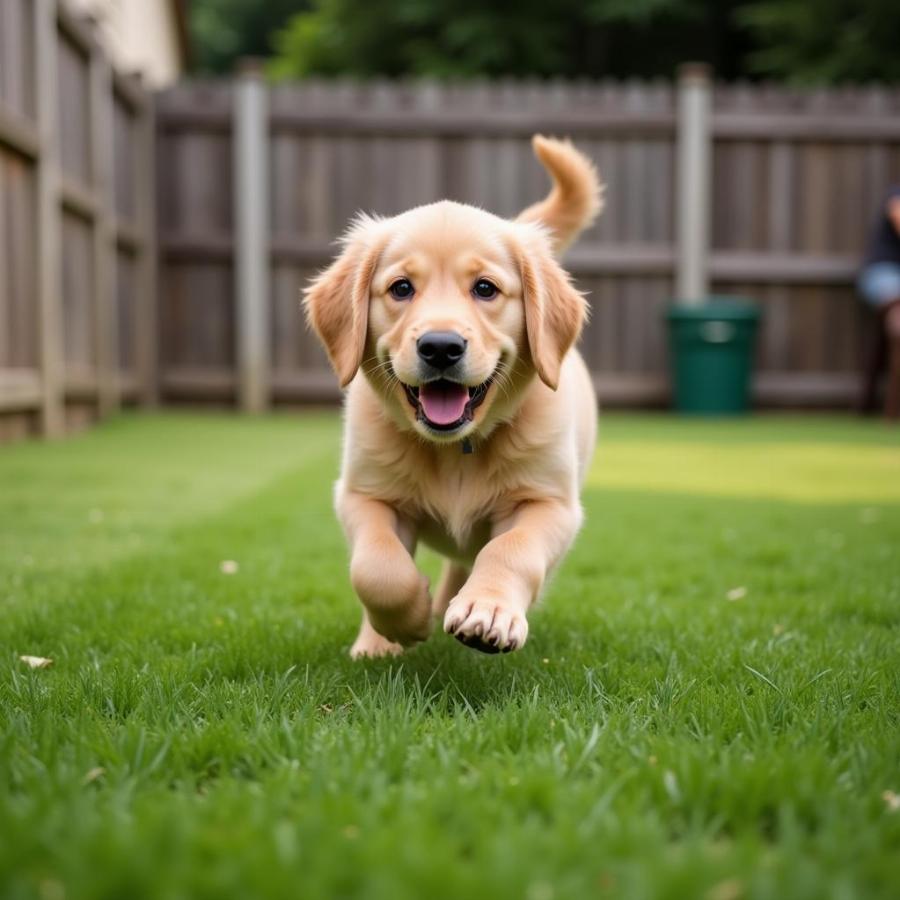Dog tie out chains are a tool that can offer dogs a degree of freedom while keeping them safely confined. However, it’s crucial to remember that using a tie out chain requires careful consideration and responsible ownership. This guide will delve into the pros and cons of dog tie out chains, factors to consider before using one, and essential safety tips to ensure your furry friend’s well-being.
Weighing the Pros and Cons of Dog Tie Out Chains
Like any pet care tool, dog tie out chains have both advantages and disadvantages. It’s vital to weigh these carefully to determine if a tie out chain is the right choice for your dog and your situation.
Pros:
- Provide a Safe Zone: Tie out chains can give your dog a designated area to enjoy the outdoors while preventing them from wandering off or getting into potentially dangerous situations.
- Offer Some Freedom: Unlike being confined to a crate or small room, a tie out chain allows your dog more freedom to move around, explore their surroundings, and enjoy fresh air and sunshine.
Cons:
- Risk of Injury: If not used correctly, tie out chains can pose entanglement hazards. Dogs can get tangled around trees, furniture, or other obstacles, leading to injuries.
- Behavioral Issues: Prolonged or inappropriate use of tie out chains can lead to frustration, boredom, and even aggression in some dogs.
Choosing the Right Tie Out Chain for Your Dog
Selecting the appropriate tie out chain for your dog is crucial for their safety and comfort. Here are key factors to consider:
- Size and Weight: The chain should be strong enough to withstand your dog’s pulling power but not excessively heavy or bulky.
- Material: Opt for rust-resistant metal chains or durable nylon webbing. Avoid thin rope chains that can easily break or fray.
- Length: Choose a length that provides adequate freedom of movement without allowing your dog to reach dangerous areas.
Essential Safety Tips for Using Dog Tie Out Chains
Using a dog tie out chain responsibly is paramount. Follow these essential safety tips to prevent accidents and ensure your dog’s well-being:
- Supervise Your Dog: Never leave your dog unattended on a tie out chain. Regular supervision is crucial to address any potential issues promptly.
- Use a Swivel: A swivel attachment at both ends of the chain prevents tangling and allows for free movement.
- Secure the Stake: Ensure the stake is firmly anchored in the ground to prevent your dog from pulling it loose.
- Provide Shade and Water: Ensure your dog has access to shade and fresh water at all times while on the tie out chain.
- Limit Tie Out Time: Avoid leaving your dog chained for extended periods. Prolonged tethering can lead to behavioral problems.
- Check for Wear and Tear: Regularly inspect the chain, collar, and stake for any signs of damage and replace them as needed.
Alternatives to Consider
While dog tie out chains can be helpful in certain situations, exploring alternative confinement options is always wise.
- Dog Fences: Installing a secure fence in your yard provides a safe and enclosed space for your dog to roam freely.
- Dog Runs: Dog runs offer a dedicated area for exercise and play while keeping your dog contained.
- Dog Walkers: If you’re unable to provide your dog with enough exercise, consider hiring a dog walker to take them for regular walks.
 Dog playing in a fenced yard
Dog playing in a fenced yard
Conclusion
Dog tie out chains can be a useful tool for dog owners, but responsible use is paramount. By carefully considering the pros and cons, choosing the right chain, and following essential safety guidelines, you can help ensure that your dog remains safe and comfortable while enjoying some outdoor time. Remember, your dog’s well-being should always come first.
FAQs About Dog Tie Out Chains
1. How long can I leave my dog on a tie out chain?
It’s generally not recommended to leave a dog on a tie out chain for extended periods. Aim for short durations and always supervise your dog.
2. What type of collar is best for a tie out chain?
A flat buckle collar is the safest option for use with a tie out chain. Avoid choke chains or prong collars, as they can cause injury.
3. Can I use a tie out chain for my puppy?
It’s best to avoid using tie out chains for puppies as they are still learning and more prone to accidents.
4. What are some signs my dog is stressed on a tie out chain?
Signs of stress can include excessive barking, whining, pacing, digging, or attempts to escape.
5. What should I do if my dog gets tangled on a tie out chain?
Stay calm and approach your dog slowly. Carefully untangle the chain, ensuring you don’t further injure your dog.
Explore More Dog Care Tips
Interested in learning more about responsible dog ownership? Check out these helpful articles:
Beaut Dogs: Your Trusted Source for Dog Information
Beaut Dogs is your one-stop resource for all things dog-related. We provide reliable and insightful information on dog breeds, care, training, and much more. Whether you’re a seasoned dog owner or a first-time pet parent, we’re here to support you every step of the way. For personalized assistance and expert advice, reach out to our team at [email protected]. Let’s give our canine companions the happy and healthy lives they deserve!